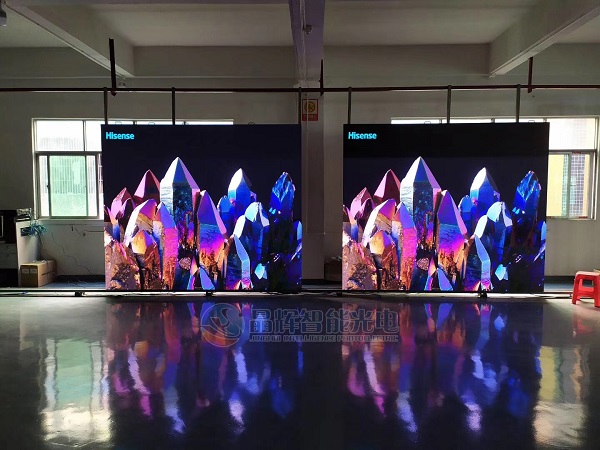
Causes of static electricity generation: From a microscopic point of view, according to atomic physics theory, matter is in an electric equilibrium state when it is electrically neutral. Due to the gain and loss of electrons generated by the contact of electrons of different matter, matter loses its electric equilibrium and generates electrostatic phenomena. Macroscopically speaking, the reasons are: friction between objects generates heat and excites electron transfer; Contact and separation between objects produce electron transfer; Electromagnetic induction causes the unbalanced distribution of surface charges of objects; The combined effect of friction and electromagnetic induction. Electrostatic voltage is generated by contact and separation of different kinds of substances. This effect is known as triboelectrification, and the voltage generated depends on the properties of the materials rubbing against each other. Because the LED display screen in the actual production process is mainly the direct contact and indirect contact between human body and related components to generate static electricity. Therefore, according to the characteristics of the industry, we can do some targeted electrostatic prevention measures. Harm of Static Electricity in LED Display Screen Production Process; If anti-static electricity is neglected in any link of production, it will cause electronic equipment failure and even damage. When semiconductor devices are placed separately or loaded into circuits, even if they are not powered on, permanent damage to these devices may occur due to static electricity. It is well known that LED is a semiconductor product. If the voltage between two or more pins of LED exceeds the breakdown strength of the component medium, the component will be damaged. The thinner the oxide layer, the greater the sensitivity of LED and driver IC to static electricity. For example, the solder is not full and there are problems with the quality of the solder itself, etc., which will cause serious leakage paths, thus causing destructive damage. Another fault is caused when the temperature of the node exceeds the melting point of semiconductor silicon (1415℃). Electrostatic pulse energy can generate local heat, thus causing direct breakdown of the lamp tube and IC. Even if the voltage is lower than the breakdown voltage of the medium, this failure will occur. A typical example is that LED is a diode composed of PN junction. Breakdown between emitter and base will sharply reduce current gain. After the LED itself or each IC in the drive circuit is affected by static electricity, functional damage may not occur immediately. These potentially damaged components usually show up during use, so the impact on the life of the LED display screen is fatal.
Protection Measures of Static Electricity in LED Display Screen Production;
I. Embedding of Antistatic Ground Wire
(1) The lightning rod of the LED display factory building is usually welded together with the reinforced concrete of the building for proper grounding. When lightning strikes occur, the grounding point and even the ground of the whole building will become the discharge point of high voltage and strong current. It is generally believed that "step voltage" will be generated within 20M of the discharge grounding point, i.e. it is no longer the ideal zero potential within this range. In addition, the zero line of the three-phase power supply will have unbalanced current due to the impossibility of absolute balance and will flow into the grounding point of the zero line, so the embedding point of the anti-static ground wire should be 20 meters away from the building and equipment ground.
(2) Embedding method: In order to ensure the reliability of grounding, at least three points or more should be grounded, i.e. more than 1.5m deep pits should be dug every 5m, more than 2m iron pipes or angle irons should be driven into the pits (i.e. angle irons should be inserted more than 2m underground), then the three points should be welded together with 3mm thick copper bars, and 16m2 insulated copper core wires should be welded into the indoor as the main line.
(3) Appropriate amount of charcoal powder and industrial salt shall be applied to the pit to increase soil conductivity. After landfill, the grounding resistance shall be less than 4Ω and tested at least once a year.
II. Grounding The grounding of LED display screen is to directly discharge static electricity to the ground through wire connection, which is the most direct and effective anti-static measure. For conductors, grounding is usually used. We require manual tools, grounding with grounding anti-static bracelet, grounding of worktable, etc.
(1) In the production process, workers are required to wear grounding electrostatic bracelets. Especially in the process of foot cutting, plug-in, debugging and post-welding, and do a good job of monitoring, quality personnel must do a bracelet electrostatic test at least every two hours, and make a good test record.
(2) During welding, antistatic low-voltage constant-temperature soldering iron shall be used as much as possible and good grounding shall be maintained.
(3) In the assembly process, use a low-voltage DC electric screwdriver (commonly known as an electric screwdriver) with grounding wire as much as possible.
(4) Ensure effective grounding of production benches, glue filling benches, aging racks, etc.
(5) We require the production environment to lay copper wires for grounding, such as floors, walls, and ceilings used in some occasions, etc. antistatic materials should be used. In general, even ordinary plasterboard and lime-coated wall surfaces can be used, but it is forbidden to use plastic ceiling, ordinary wall paper or plastic wall paper.

 Follow us
Follow us
No. 31, Qiaotang Road, Tangwei Community, Fuhai Street, Baoan District, Shenzhen
JHled888@163.com
COPYRIGHT 2019 Daming Palace Display Technology Co., Ltd. ALL RIGHTS RESERVED.